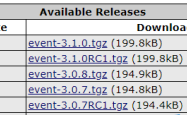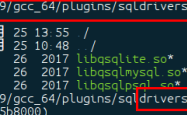centos7环境下swoole1.9的安装与HttpServer的使用方法分析
本文实例讲述了centos7环境下swoole1.9的安装与HttpServer的使用方法。分享给大家供大家参考,具体如下:
一、下载swoole源码包
https://github.com/swoole/swoole-src/releases
如:swoole-src-1.9.6.tar.gz
二、编译安装
?| 1 2 3 | > yum install gcc gcc-c++ kernel-devel make autoconf > tar xf swoole-src-1.9.6. tar .gz > cd swoole-src-1.9.6 |
我的php是安装在/data/php56下,请自行修改
?| 1 2 3 | > /data/php56/bin/phpize > . /configure > make && make install |
修改php.ini文件添加如下两行
?| 1 | > vi /data/php56/lib/php .ini |
以下路径请根据自的环境修改
?| 1 2 | extension_dir = "/data/php56/lib/php/extensions/no-debug-zts-20131226/" extension=swoole.so |
查看扩展是否装上
?| 1 | > /data/php56/bin/php -m| grep swoole |
三、HttpServer的使用
http.php代码如下:
?| 1 2 3 4 5 6 7 8 9 10 11 12 13 14 15 | <?php $http = new swoole_http_server( '0.0.0.0' , 8888); //设置回调函数,当收到请求时,会回调此函数 $http ->on( 'request' , function ( $request , $response ) { //$request包含了客户端请求的信息 var_dump( $request ); //$response服务端响应信息 var_dump( $response ); //向客户端发送404状态码 $response ->status(404); //向客户端发送hello $response -> end ( 'hello' ); }); //启动http服务 $http ->start(); |
运行该脚本
?| 1 | > /data/php56/bin/php http.php |
1、HttpServer如何处理静态文件?
一般是分析客户端发送的请求信息,如果是一个文件,那么读取并发送给客户端,如果不是则返回404。
?| 1 2 3 4 5 6 7 8 9 10 11 12 13 14 15 16 17 18 19 20 21 | <?php $http = new swoole_http_server( '0.0.0.0' , 8888); //设置回调函数,当收到请求时,会回调此函数 $http ->on( 'request' , function ( $request , $response ) { $pathInfo = $request ->server[ 'path_info' ]; $file = __DIR__ . $pathInfo ; //获取文件的MIME $fileInfo = finfo_open(FILEINFO_MIME); $fileMime = finfo_file( $fileInfo , $file ); if ( is_file ( $file )) { //这里需要手动设置文件MIME格式 $response ->header( 'Content-Type' , $fileMime ); $response ->sendfile( $file ); } else { $response ->status(404); $response -> end ( 'not found' ); } }); //启动http服务 $http ->start(); |
我们在http.php同目录下放上一张1.jpg图片,然后请求192.168.1.222:8888/1.jpg就可正常访问。
2、HttpServer如何处理动态php文件?
?| 1 2 3 4 5 6 7 8 9 10 11 12 13 14 15 16 17 18 19 20 21 22 23 24 25 | <?php $http = new swoole_http_server( '0.0.0.0' , 8888); //设置回调函数,当收到请求时,会回调此函数 $http ->on( 'request' , function ( $request , $response ) { $pathInfo = $request ->server[ 'path_info' ]; $file = __DIR__ . $pathInfo ; if ( is_file ( $file )) { //判断文件后缀名 if ( pathinfo ( $pathInfo )[ 'extension' ] == 'php' ) { ob_start(); include $file ; $content = ob_get_contents(); ob_end_clean(); $response -> end ( $content ); } else { //处理其他文件 } } else { $response ->status(404); $response -> end ( 'not found' ); } }); //启动http服务 $http ->start(); |
我们在http.php同目录下创建1.php脚本,然后请求192.168.1.222:8888/1.php就可正常访问。
3、HttpServer的守护进程化?
只需设置配置参数daemonize为1就可以了。
?| 1 2 3 4 5 6 7 8 9 10 11 12 13 14 15 16 17 18 19 20 21 22 23 24 25 26 27 28 29 30 31 32 | <?php $http = new swoole_http_server( '0.0.0.0' , 8888); //设置进程数量,和守护进程化 $http ->set( array ( 'worker_num' => 4, 'daemonize' => 1, )); //设置回调函数,当收到请求时,会回调此函数 $http ->on( 'request' , function ( $request , $response ) { $pathInfo = $request ->server[ 'path_info' ]; $file = __DIR__ . $pathInfo ; if ( is_file ( $file )) { //判断文件后缀名 if ( pathinfo ( $pathInfo )[ 'extension' ] == 'php' ) { ob_start(); include $file ; $content = ob_get_contents(); ob_end_clean(); $response -> end ( $content ); } else { } } else { $response ->status(404); $response -> end ( 'not found' ); } }); //启动http服务 $http ->start(); |
希望本文所述对大家PHP程序设计有所帮助。
原文链接:https://www.cnblogs.com/jkko123/p/6509976.html
1.本站遵循行业规范,任何转载的稿件都会明确标注作者和来源;2.本站的原创文章,请转载时务必注明文章作者和来源,不尊重原创的行为我们将追究责任;3.作者投稿可能会经我们编辑修改或补充。











